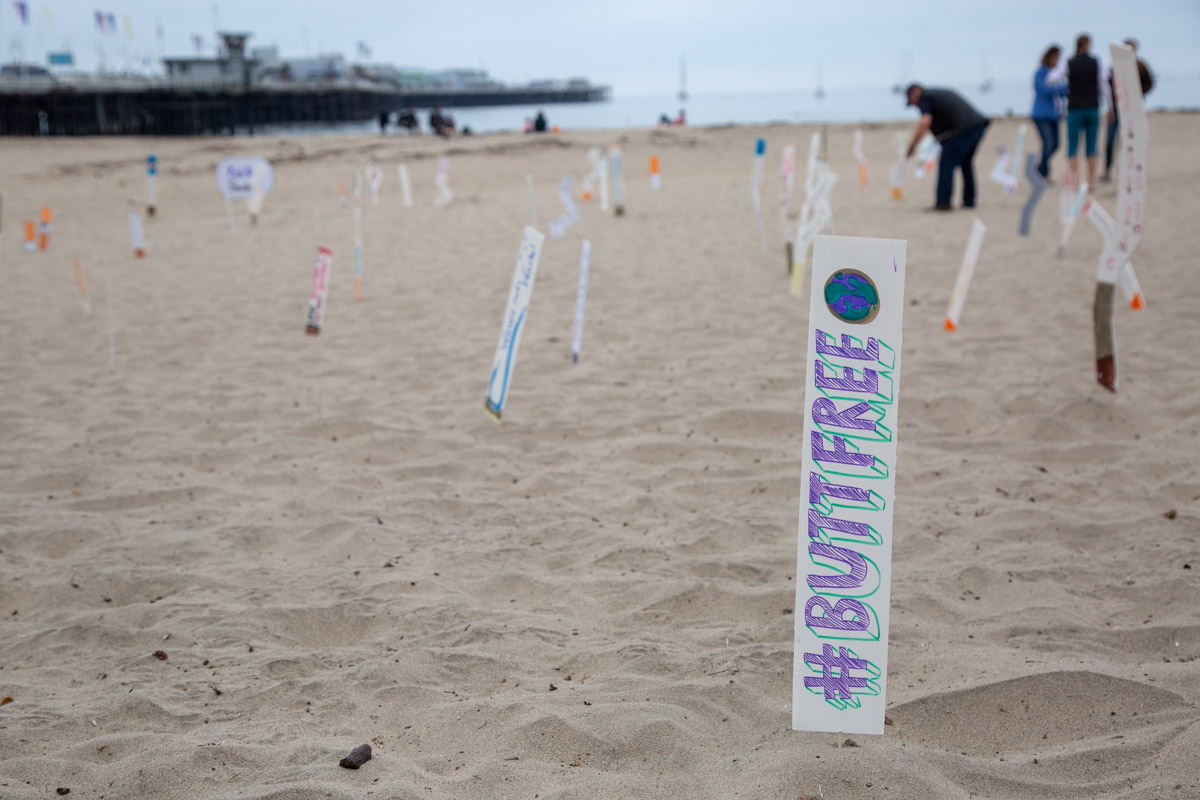Tobacco Butts Pack a Poisonous Punch for People and the Ocean

Today’s guest blog comes from Tara Leonard, MPH. Tara is a Health Educator in the Santa Cruz County Tobacco Education and Prevention Program. All display materials were removed from Cowell Beach for use at future events.
While physically small, tobacco filters, or butts, pack a poisonous punch. What would happen if the public could actually see hundreds of these toxic bombs littering a local beach where families and children play? That’s the question the Santa Cruz County Tobacco Education Coalition (TEC) set out to answer last weekend in a small California beach town.
The TEC is a community group that advocates for a tobacco-free lifestyle and environment. Members knew that every year during Ocean Conservancy’s International Coastal Cleanup, cigarette butts topped the list of most littered items. In 2017, cleanup participants around the world picked up 2,412,151 butts (203,474 in California alone), outpacing bottle caps, food wrappers, plastics bags and straws. Yet, while other plastic waste items face growing public scrutiny, tobacco butts have remained largely under the public’s radar.
“Tobacco butts are so ubiquitous that most of us have become blind to them,” said Coalition Co-Chair, Rachel Kippen. “There are 4.5 trillion of them littering our streets, parks and beaches around the globe. Most people don’t realize that butts are made from cellulose acetate, a plastic that never entirely degrades. These filters provide no health benefit to smokers but create a lasting environmental threat, especially for the ocean, when they are inappropriately discarded – which the majority of them are.”
Cigarette butts contain dangerous chemicals such as arsenic, lead and nicotine—the same chemicals found in secondhand smoke. Improperly discarded butts are a danger to children, pets and wildlife. Washed into waterways, they’re also toxic to fresh and saltwater organisms. Field biologists and wildlife rehabilitators routinely find butts in the intestines of dead or sick seabirds, sea turtles, fish and dolphins. But how do you make the public see just how big a problem tobacco butts really are?
On August 26th, the TEC invited the public to Cowell Beach in Santa Cruz for a cleanup and activist art event co-sponsored by two local nonprofits, Save Our Shores and the Downtown Streets Team. After scouring the beach, volunteers traded the cigarette butts they collected for more than 150 larger-than-life replicas, each bearing a personal message about the human and environmental toll of tobacco and tobacco waste. “I’m a beach, not an ashtray,” read one. “Sea lions don’t smoke” said another. Some participants used humor writing, “The only butts on the beach should be human butts!” and “Do as you otter, don’t pollute our water.” One went for the direct approach writing simply, “I hate cigarettes.”

Ironically, decreasing smoking rates may contribute to the lack of public awareness about the tobacco waste issue. “Most of us have used a plastic bag or plastic straw,” said Kippen. “So we feel a sense of responsibility for how those products are revised, reused, or recycled to be more environmentally friendly. However, most of us don’t smoke. In fact, less than 12% of California residents smoke. That leaves 88% wondering how to make a difference.”
Previous approaches haven’t solved the problem. While more trash receptacles and no-smoking signs are helpful, it’s common to see dozens of butts on the ground within feet of a trash can. Likewise, enforcement of existing littering and no-smoking laws hasn’t proven effective. During the two-hour Santa Cruz cleanup, volunteers removed 516 cigarette butts on a beach that is supposed to be smoke free.
“Obviously we can’t depend on individual smokers to change their behavior,” said Solano. “It’s time for the tobacco industry to take responsibility for their toxic waste instead of relying on local governments and volunteers. They need to remove or revise plastic filters or start compensating local jurisdictions who currently pay for cleanup.”
While lawyers and elected officials work on developing a policy, the TEC and other health and environmental groups will continue to educate the public and pressure the industry. Because, as one young cleanup participant wrote on his cigarette replica, “Butts are gross!”
If you’d like to help make a difference, attend Ocean Conservancy’s 2018 International Coastal Cleanup on Saturday, September 15th. Go to www.signuptocleanup.org to learn how you can join hundreds of thousands of other volunteers to comb lakes, rivers and beaches around the world for trash, including those noxious, ever-present cigarette butts!